| July 30, 2007 |  |
our time will build eternity |
| Previous Issues | Jul 27 | Jul 26 | Jul 25 | Jul 24 | Jul 23 |
Mars Winds Could Pose Stiff Challenge For NASA's Phoenix Lander Team Ann Arbor MI (SPX) Jul 27, 2007
Ann Arbor MI (SPX) Jul 27, 2007Martian winds probably won't cause serious problems for NASA's upcoming Phoenix Mars Lander mission but could complicate efforts to collect soil and ice at the landing site, according to University of Michigan atmospheric scientist Nilton Renno. New results from U-M wind tunnel tests suggest that winds could blow away some of the laboriously collected soil and ice, but probably not enough to aff ... more Europe Asks Thales Alenia Space For The Price Of A Mars Robotic Rover  Cannes, France (UPI) Jul 27, 2007
Cannes, France (UPI) Jul 27, 2007The European Space Agency has asked Cannes, France, satellite manufacturer Thales Alenia Space to quote a price on the construction of a Mars rover. The French-Italian satellite company announced it will convene a meeting of its major contractors next week to discuss the rover, which the ESA is planning to send to Mars in 2013, the BBC reported Thursday. ESA delegations approved the genera ... more Crustacean Shells Might Hold Secret To Safer Long-Range Space Travel  Boxford, MA (SPX) Jul 25, 2007
Boxford, MA (SPX) Jul 25, 2007A team of researchers is seeking to determine if an ingredient found in shrimp and lobster shells might make future missions to Mars safer for space crews who could be injured along the way. Scientists from Harvey Mudd College (HMC) in California and the University of Louisville are collaborating with bioengineering and biomaterials company BioSTAR West on research efforts to better understand h ... more Search For Life In Martian Ice Relies On UK Technology  London UK (SPX) Jul 26, 2007
London UK (SPX) Jul 26, 2007The Martian surface will be explored for conditions favourable for past or present life thanks to micro-machine technology supplied by Imperial College London. The NASA mission, planned for August 2007, represents the first chance for UK hardware to contribute to the exploration of Mars since the failed Beagle 2 spacecraft launched in 2003. Dr Tom Pike and his team at Imperial's Department of El ... more Opportunity Calls Home After Some Solar Juice Cranks Up The Batteries  Los Angeles CA (JPL) Jul 24, 2007
Los Angeles CA (JPL) Jul 24, 2007Mars Exploration Rover Opportunity called home Monday morning indicating the power situation improved slightly during recent days when it obeyed commands to refrain from communicating with Earth in order to conserve power. Dust storms on Mars have darkened skies over Opportunity and its twin, Spirit. The rovers rely on solar panels to generate electricity from sunlight. Last week, solarcell output for Opportunity had dropped by 80 percent from a month earlier. ... more |
mars-exomars
 mars-water-science 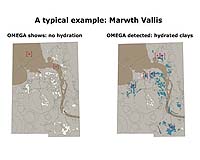 mars-mers 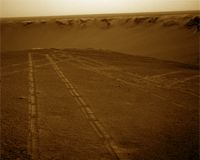 |
 Waltham, MA (SPX) Jul 21, 2007
Waltham, MA (SPX) Jul 21, 2007Did the Mars Exploration Rovers find evidence of life on the Red planet? How long is a Martian year? Today, nearly 100 Washington area YMCA summer campers, ages 11-13 years, learned the answers to these questions when they teamed with Raytheon for a celebration of the planet Mars. Raytheon, as part of its MathMovesU middle school initiative, is showing young people how engaging math and scienc ... more HiRISE Catches A Dust Devil On Mars  Tucson AZ (SPX) Jul 21, 2007
Tucson AZ (SPX) Jul 21, 2007The University of Arizona-based High Resolution Imaging Experiment (HiRISE) group this week released a good look at a dust devil on Mars. This is not the storm bedeviling NASA's Mars Exploration Rovers, Spirit and Opportunity. The HiRISE camera captured the dust twister by chance in its photographic swath of a region in the southern hemisphere near Hellas Planitia during a Martian mid-afternoon ... more NASA Robots Practice Moon Survey In The Arctic Circle  Moffett Field CA (SPX) Jul 21, 2007
Moffett Field CA (SPX) Jul 21, 2007Two NASA robots are surveying a rocky, isolated polar desert within a crater in the Arctic Circle. The study will help scientists learn how robots could evaluate potential outposts on the moon or Mars. The robots, K10 Black and K10 Red, carry 3-D laser scanners and ground-penetrating radar. The team arrived at Haughton Crater at Devon Island, Canada, on July 12 and will operate the machines un ... more Layers Exposed In Crater Near Mawrth Vallis  Tempe AZ (SPX) Jul 19, 2007
Tempe AZ (SPX) Jul 19, 2007This image covers an impact crater roughly 4 kilometers (2.5 miles) in diameter. The subimage shows just a small segment of the crater rim (1336 x 889; 3 MB). The surface outside the crater (top) is relatively dark, while the interior wall of the crater has a lighter tone. A few dark patches on the crater wall have small dunes or ripples on their surfaces, and are likely pits filled with dark sa ... more |
mars-atmosphere
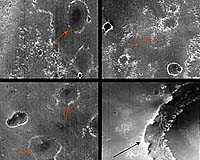 mars-robot 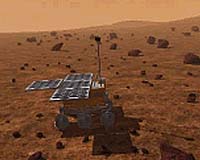 mars-phoenix  |
 Pasadena CA (JPL) Jul 17, 2007
Pasadena CA (JPL) Jul 17, 2007Due to extensive dust storms in Mars' southern hemisphere causing record atmospheric opacity levels, Opportunity is currently experiencing its lowest power levels to date. The tau measurement as of sol 1225 is 4.12, resulting in a mere 280 watt-hours of array energy. A tau measurement of 5.0 would result in approximately 150 watt-hours. If tau begins to approach 5.0, the team will have to begin ... more The Origin Of Perennial Water-Ice At The South Pole Of Mars  Paris, France (ESA) Jul 16, 2007
Paris, France (ESA) Jul 16, 2007Thanks to data from ESA's Mars Express mission, combined with models of the Martian climate, scientists can now suggest how the orbit of Mars around the Sun affects the deposition of water ice at the Martian South Pole. Early during the mission, the OMEGA instrument (Visible and Infrared Mineralogical Mapping Spectrometer) on board Mars Express had already found previously undetected perennial d ... more Arizona State Scientists Keep An Eye On Martian Dust Storm  Tempe AZ (SPX) Jul 13, 2007
Tempe AZ (SPX) Jul 13, 2007Scientists at Arizona State University's Mars Space Flight Center are using the Thermal Emission Imaging System (THEMIS) on NASA's Mars Odyssey orbiter to monitor a large dust storm on the Red Planet. The instrument, a multi-wavelength camera sensitive to five visible wavelengths and 10 infrared ones, is providing Mars scientists and spacecraft controllers with global maps that track how much at ... more NASA Readies Mars Lander For August Launch To Icy Site  Washington DC (SPX) Jul 10, 2007
Washington DC (SPX) Jul 10, 2007NASA's next Mars mission will look beneath a frigid arctic landscape for conditions favorable to past or present life. Instead of roving to hills or craters, NASA's Phoenix Mars Lander will claw down into the icy soil of the Red Planet's northern plains. The robot will investigate whether frozen water near the Martian surface might periodically melt enough to sustain a livable environment for mi ... more
|
asteroid
 asteroid 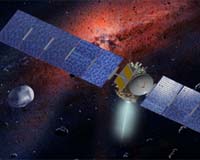 mars-mers  |
| Previous Issues | Jul 27 | Jul 26 | Jul 25 | Jul 24 | Jul 23 |
| The contents herein, unless otherwise known to be public domain, are Copyright 1995-2007 - SpaceDaily. AFP and UPI Wire Stories are copyright Agence France-Presse and United Press International. ESA Portal Reports are copyright European Space Agency. All NASA sourced material is public domain. Additional copyrights may apply in whole or part to other bona fide parties. Advertising does not imply endorsement, agreement or approval of any opinions, statements or information provided by SpaceDaily on any web page published or hosted by SpaceDaily. Privacy statement |